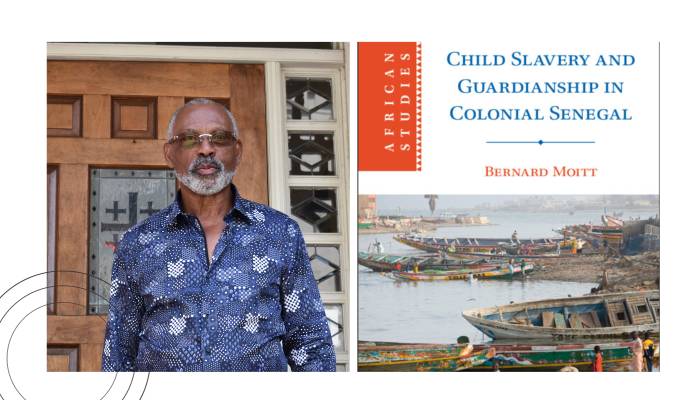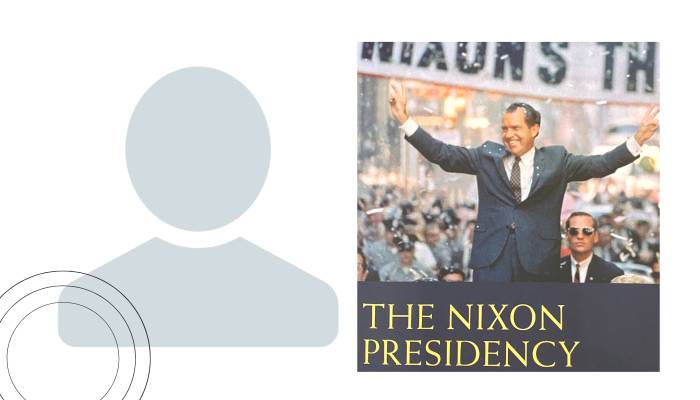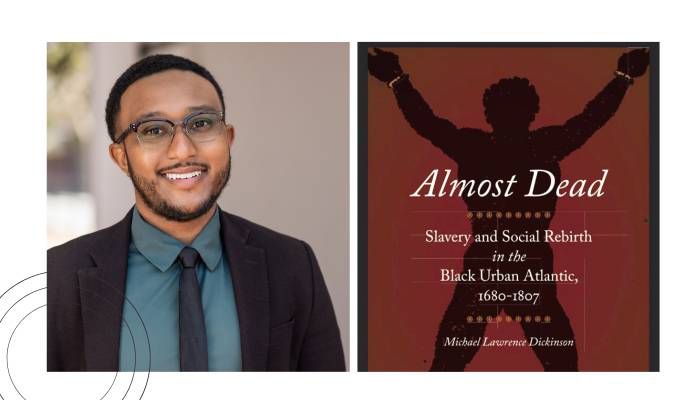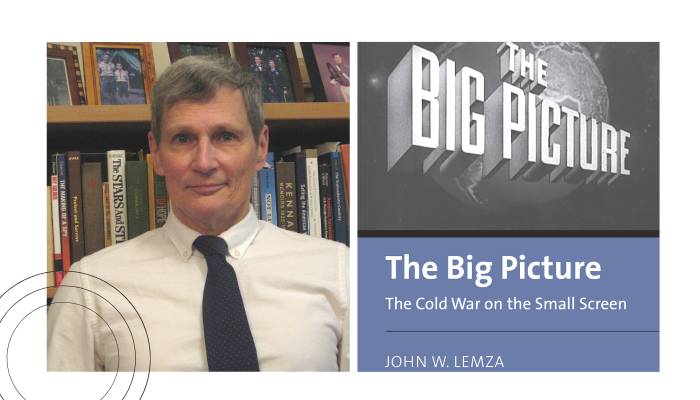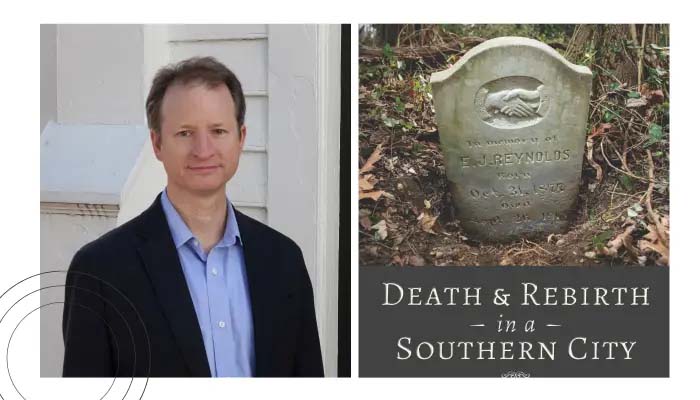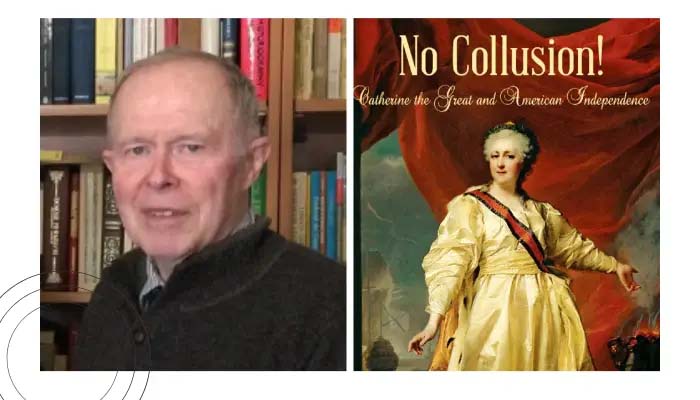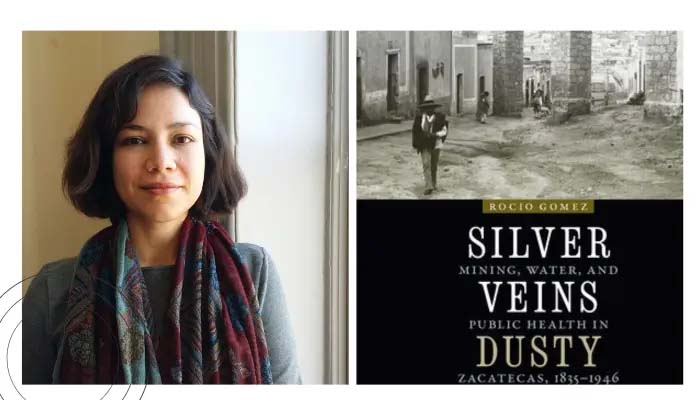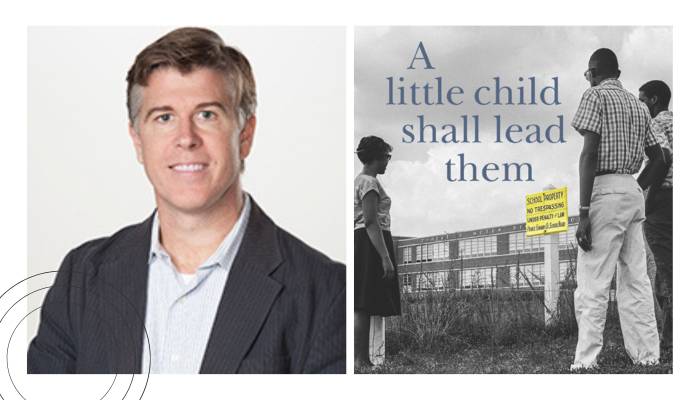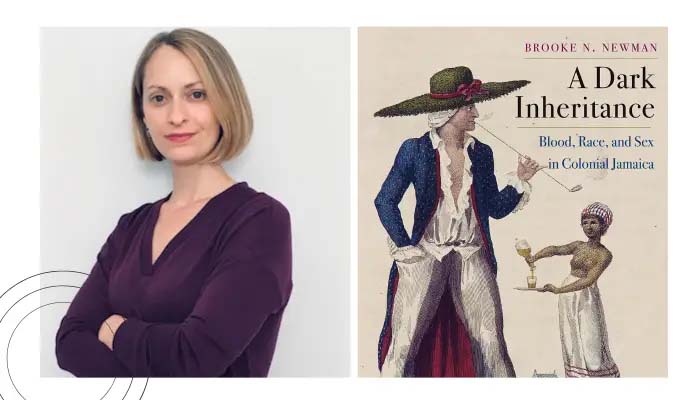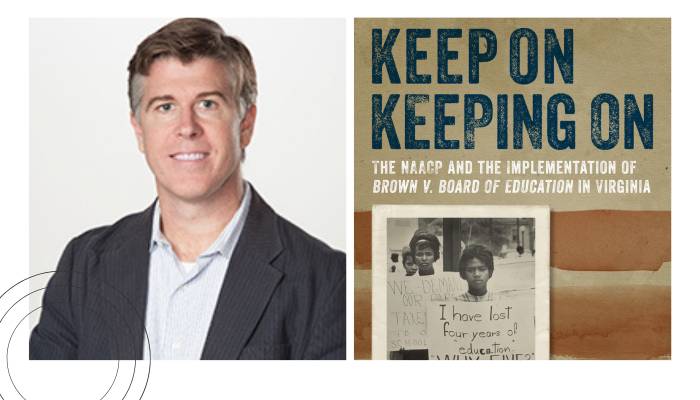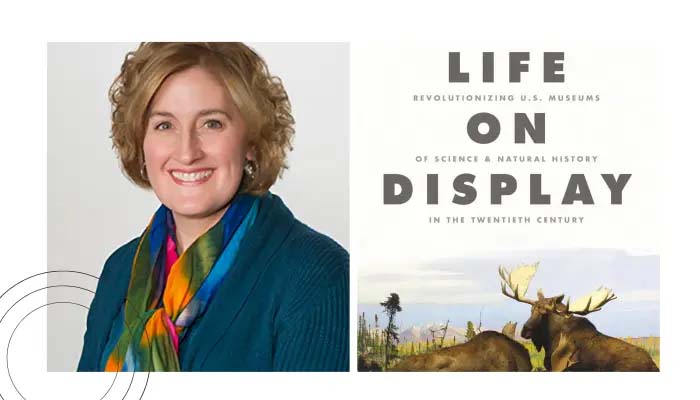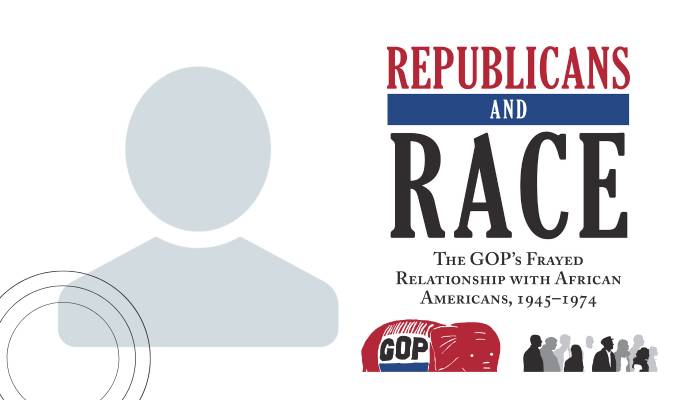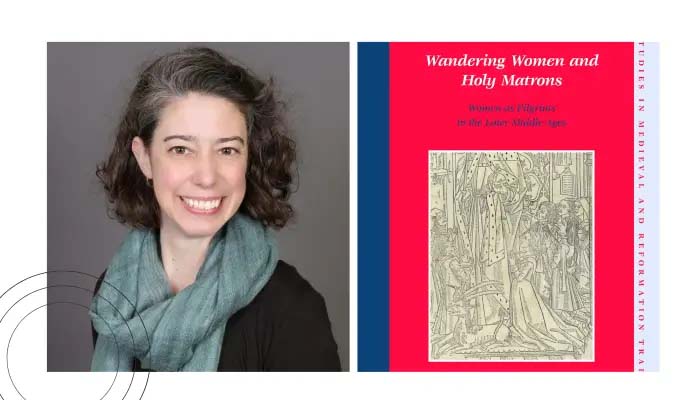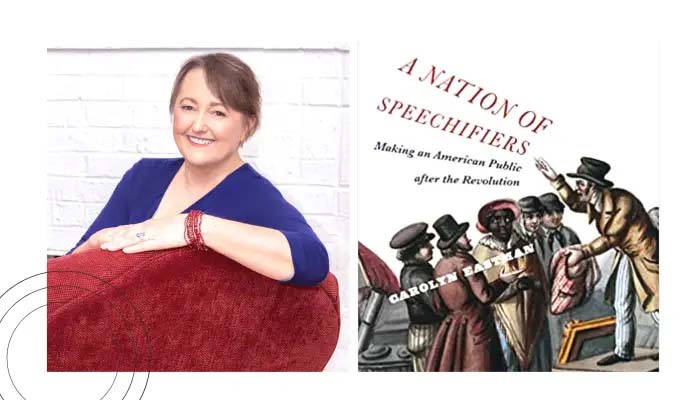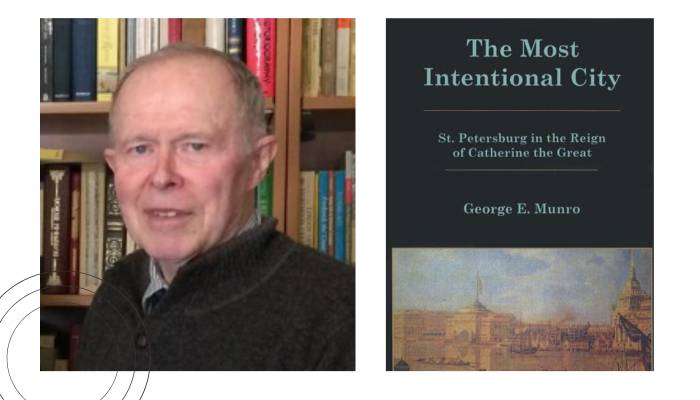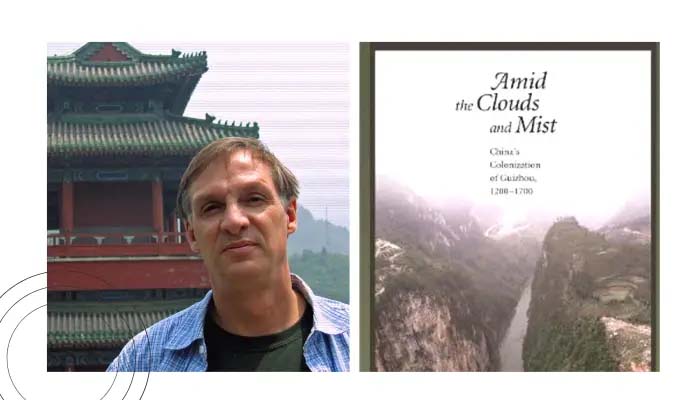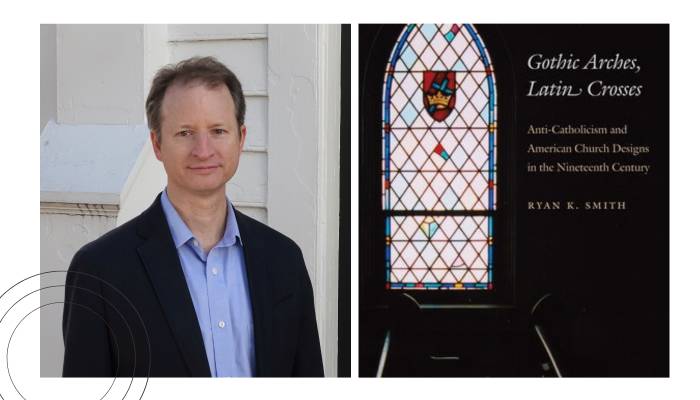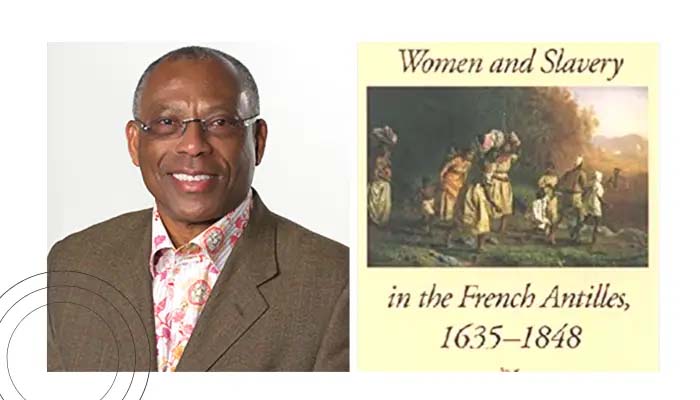Faculty Bookshelf
Between Here and There
Creating the Political Economy of Mexican Migration, 1900-1942
Daniel Morales, Ph.D.
Charles A. Willoughby and the Anti-Communist Crusade
Forging the Geopolitics of the American Old Right
John W. Lemza, Ph.D.
Child Slavery and Guardianship in Colonial Senegal
Bernard Moitt, Ph.D.
The Nixon Presidency
Timothy N. Thurber, Ph.D.
Almost Dead
Slavery and Social Rebirth in the Black Urban Atlantic, 1680-1807
Michael Lawrence Dickinson, Ph.D.
Reclaiming Two-Spirits
Sexuality, Spiritual Renewal & Sovereignty in Native America
Gregory Smithers, Ph.D.
The Strange Genius of Mr. O
The World of the United States’ First Forgotten Celebrity
Carolyn Eastman, Ph.D.
Fulfilling the Promise
Virginia Commonwealth University and the City of Richmond, 1968–2009
John Kneebone, Ph.D. and Eugene Trani, Ph.D.
No Collusion!
Catherine the Great and American Independence
David M. Griffiths, edited by George E. Munro, Ph.D.
A Concise History of Nazi Germany
Joseph W. Bendersky, Ph.D.
A Little Child Shall Lead Them
A Documentary Account of the Struggle for School Desegregation in Prince Edward County, Virginia
Brian J. Daugherity, Ph.D., and Brian Grogan
The Cherokee Diaspora
An Indigenous History of Migration, Resettlement, and Identity
Gregory D. Smithers, Ph.D.
Keep On Keeping On
The NAACP and the Implementation of Brown v. Board of Education in Virginia
Brian J. Daugherity, Ph.D.
Racism in American Popular Media
From Aunt Jemima to the Frito Bandito
Gregory Smithers, Ph.D., and Brian D. Behnken, Ph.D.
Selected Discourses of Shenoute the Great
Community, Theology, and Social Conflict in Late Antique Egypt
Andrew Crislip, Ph.D. and David Brakke, Ph.D - translators
Life on Display
Revolutionizing U.S. Museums of Science and Natural History in the Twentieth Century
Karen A. Rader, Ph.D. and Victoria E. M. Cain, Ph.D.
Robert Morris's Folly
The Architectural and Financial Failures of an American Founder
Ryan K. Smith, Ph.D.
Education and the State in Modern Peru
Primary Schooling in Lima, 1821–c. 1921
G. Antonio Espinoza, Ph.D.
Republicans and Race
The GOP's Frayed Relationship with African Americans, 1945-1974
Timothy N. Thurber
Every Home a Distillery
Alcohol, Gender, and Technology in the Colonial Chesapeake
Sarah Hand Meacham, Ph.D.
With All Deliberate Speed
Implementing Brown v. Board of Education
Brian J. Daugherity, Ph.D., and Charles C. Bolton, Ph.D.
Gothic Arches, Latin Crosses
Anti-Catholicism and American Church Designs in the Nineteenth Century
Ryan K. Smith, Ph.D.
Sugar, Slavery, and Society
Perspectives on the Caribbean, India, the Mascarenes, and the United States
Bernard Moitt, Ph.D.
Women and Slavery in the French Antilles, 1635-1848
Bernard Moitt, Ph.D.
Primary Schooling in Lima, 1821–c. 1921
Espinoza’s work illuminates how education was the site of ideological and political struggle in Peru during its early years as an independent state. Spanning 100 years and discussing both urban and rural education, it shows how school funding, curricula, and governance became part of the cultural process of state-building in Peru.
Publisher/year published: Palgrave Macmillan; 2013th edition December 9, 2013
Women as Pilgrims in the Later Middle Ages
This book explores women’s experiences of pilgrimage in Latin Christendom between 1300 and 1500 C.E. Later medieval authors harbored grave doubts about women’s mobility; literary images of mobile women commonly accused them of lust, pride, greed, and deceit. Yet real women commonly engaged in pilgrimage in a variety of forms, both physical and spiritual, voluntary and compulsory, and to locations nearby and distant. Acting within both practical and social constraints, such women helped to construct more positive interpretations of their desire to travel and of their experiences as pilgrims. Regardless of how their travel was interpreted, those women who succeeded in becoming pilgrims offer us a rare glimpse of ordinary women taking on extraordinary religious and social authority.
Publisher/year published: Brill; Illustrated edition March 31, 2009
Illness and Sanctity in Late Ancient Christianity
The literature of late ancient Christianity is rich both in saints who lead lives of almost Edenic health and in saints who court and endure horrifying diseases. In such narratives, health and illness might signify the sanctity of the ascetic, or invite consideration of a broader theology of illness. In Thorns in the Flesh, Andrew Crislip draws on a wide range of texts from the fourth through sixth centuries that reflect persistent and contentious attempts to make sense of the illness of the ostensibly holy. These sources include Lives of Antony, Paul, Pachomius, and others; theological treatises by Basil of Caesarea and Evagrius of Pontus; and collections of correspondence from the period such as the Letters of Barsanuphius and John.
Publisher/year published: University of Pennsylvania Press October 11, 2012
Hollywood, Black Celebrities, and the Civil Rights Movement
From Oprah Winfrey to Angelina Jolie, George Clooney to Leonardo DiCaprio, Americans have come to expect that Hollywood celebrities will be outspoken advocates for social and political causes. However, that wasn’t always the case. As Emilie Raymond shows, during the civil rights movement the Stars for Freedom – a handful of celebrities both black and white – risked their careers by crusading for racial equality, and forged the role of celebrity in American political culture.
Focusing on the “Leading Six” trailblazers – Harry Belafonte, Ossie Davis, Ruby Dee, Sammy Davis, Jr., Dick Gregory, and Sidney Poitier – Raymond reveals how they not only advanced the civil rights movement in front of the cameras, but also worked tirelessly behind the scenes, raising money for Martin Luther King, Jr.’s legal defense, leading membership drives for the NAACP, and personally engaging with workaday activists to boost morale.
Through meticulous research, engaging writing, and new interviews with key players, Raymond traces the careers of the Leading Six against the backdrop of the movement. Perhaps most revealing is the new light she sheds on Sammy Davis, Jr., exploring how his controversial public image allowed him to raise more money for the movement than any other celebrity. The result is an entertaining and informative book that will appeal to film buffs and civil rights historians alike, as well as to anyone interested in the rise of celebrity power in American society.
Publisher/year published: University of Washington Press; Illustrated edition – May 1, 2015
From Aunt Jemima to the Frito Bandito
Were there damaging racist depictions in Gone with the Wind and children’s cartoons such as Tom and Jerry and Mickey Mouse? How did widely known stereotypes of the Latin lover, the lazy Latino, the noble savage and the violent warrior American Indian, and the Asian as either a martial artist or immoral and tricky come about? This book utilizes an ethnic and racial comparative approach to examine the racism evidenced in multiple forms of popular media, enabling readers to apply their critical thinking skills to compare and analyze stereotypes, grasp the often-subtle sources of racism in the everyday world around us, and understand how racism in the media was used to unite white Americans and exclude ethnic people from the body politic of the United States.
Publisher/year published: Praeger; Illustrated edition March 24, 2015
This balanced history offers a concise, readable introduction to Nazi Germany. Combining compelling narrative storytelling with analysis, Joseph W. Bendersky offers an authoritative survey of the major political, economic, and social factors that powered the rise and fall of the Third Reich. Now in its fifth edition, the book incorporates significant research of recent years, analysis of the politics of memory, postwar German controversies about World War II and the Nazi era, and more on non-Jewish victims. Delving into the complexity of social life within the Nazi state, it also reemphasizes the crucial role played by racial ideology in determining the policies and practices of the Third Reich. Bendersky paints a fascinating picture of how average citizens negotiated their way through both the threatening power behind certain Nazi policies and the strong enticements to acquiesce or collaborate. His classic treatment provides an invaluable overview of a subject that retains its historical significance and contemporary importance.
Publisher/year published: Rowman & Littlefield Publishers, September 2020
Herman Boerhaave and the Reform of the Chemical Arts
In Inventing Chemistry, historian John C. Powers turns his attention to Herman Boerhaave (1668–1738), a Dutch medical and chemical professor whose work reached a wide, educated audience and became the template for chemical knowledge in the eighteenth century. The primary focus of this study is Boerhaave’s educational philosophy, and Powers traces its development from Boerhaave’s early days as a student in Leiden through his publication of the Elementa chemiae in 1732. Powers reveals how Boerhaave restructured and reinterpreted various practices from diverse chemical traditions (including craft chemistry, Paracelsian medical chemistry, and alchemy), shaping them into a chemical course that conformed to the pedagogical and philosophical norms of Leiden University’s medical faculty. In doing so, Boerhaave gave his chemistry a coherent organizational structure and philosophical foundation and thus transformed an artisanal practice into an academic discipline. Inventing Chemistry is essential reading for historians of chemistry, medicine, and academic life.
Publisher/year published: University of Chicago Press – 2012
Anti-Semitic Politics of the U.S. Army
While the pervasive anti-Semitism of “ordinary” Germans in the first half of the twentieth century has received much attention lately, very little has been written about America’s own history of anti-Semitism. In this shocking book, Joseph Bendersky argues that such racism permeated the highest ranks of the U.S. military throughout the past century, having a very real effect on policy decisions. Through ten years of research in more than thirty-five archives, the author has uncovered irrefutable evidence of an endemic and virulent anti-Semitism throughout the Army Corps from the turn of the century right up to the 1970s. These sources reveal how the “Secret Americans” (a group of officers who described themselves as true patriots and who felt silenced by Roosevelt) were convinced of the physical, intellectual, and moral inferiority of Jews and feared that their “superior” Anglo-Saxon/Nordic culture was threatened by a radical and destabilizing Jewish conspiracy. This fully developed and clearly articulated perspective had a direct effect on policy discussions and decisions, affecting such matters as immigration, refugees, military strategy, and the establishment of Israel. Secret agents scoured Europe in a desperate attempt to prove the existence of the Jewish conspiracy. General Moseley, a close friend of Eisenhower’s and one of the Army’s most decorated officers, demanded the sterilization of Jewish refugees from Nazi Germany. During the war, the Chief of the Naval Institute claimed the stream of Jewish refugees from Europe was just a money-making scheme. Even in the 1970s, retired officers were still warning against the secret forces of Judaism and their supposed manipulation of presidents and the American public (even going so far as to label Kissinger a KGB spy). Written with novelistic intensity and attention to intriguing detail, The “Jewish Threat” is the first documented examination of a functioning anti-Semitic worldview within an American institution of government and adds an entirely new dimension to the history of the U.S. Army. It forces us to revise some of our cherished notions about our country and its most revered leaders.
Publisher/year published: Basic Books – 2001
Standardizing Animals for American Biomedical Research, 1900-1955
Karen Rader introduces us to mouse “fanciers” who bred mice for different characteristics, to scientific entrepreneurs like geneticist C. C. Little, and to the emerging structures of modern biomedical research centered around the National Institutes of Health. Throughout Making Mice, Rader explains how the story of mouse research illuminates our understanding of key issues in the history of science such as the role of model organisms in furthering scientific thought. Ultimately, genetically standardized mice became icons of standardization in biomedicine by successfully negotiating the tension between the natural and the man-made in experimental practice.
Publisher / year published: Princeton University Press, March 2004
A Documentary Account of the Struggle for School Desegregation in Prince Edward County, Virginia
In the twentieth-century struggle for racial equality, there was perhaps no setting more fraught and contentious than the public schools of the American south. In Prince Edward County, Virginia, in 1951, a student strike for better school facilities became part of the NAACP legal campaign for school desegregation. That step ultimately brought this rural, agricultural county to the Supreme Court of the United States as one of five consolidated cases in the historic 1954 ruling, Brown v. Board of Education. Unique among those cases, Prince Edward County took the extreme stance of closing its public school system entirely rather than comply with the desegregation ruling of the Court. The schools were closed for five years, from 1959 to 1964, until the Supreme Court ruling in Griffin v. County School Board of Prince Edward County ordered the restoration of public education in the county.
This historical anthology brings together court cases, government documents, personal and scholarly writings, speeches, and journalism to represent the diverse voices and viewpoints of the battle in Prince Edward County for—and against—educational equality. Providing historical context and contemporary analysis, this book offers a new perspective of a largely overlooked episode and seeks to help place the struggle for public education in Prince Edward County into its proper place in the civil rights era.
Publisher/year published: University of Virginia Press – 2019
The NAACP and the Implementation of Brown v. Board of Education in Virginia
Virginia was a battleground state in the struggle to implement Brown v. Board of Education, with one of the South’s largest and strongest NAACP units fighting against a program of noncompliance crafted by the state’s political leaders. Keep On Keeping On offers a detailed examination of how African Americans and the NAACP in Virginia successfully pursued a legal agenda that provided new educational opportunities for the state’s black population in the face of fierce opposition from segregationists and the Democratic Party of Harry F. Byrd Sr.
Keep On Keeping On is the first book to offer a comprehensive view of African Americans’ efforts to obtain racial equality in Virginia in the later twentieth century. Brian J. Daugherity considers the relationship between the various levels of the NAACP, the ideas and actions of other African American organizations, and the stances of Virginia’s political leaders, white liberals and moderates, and segregationists. In doing so, the author provides a better understanding of the connections between the actions of white political leaders and those of black civil rights activists working to bring about school desegregation. Blending social, legal, southern, and African American history, this book sheds new light on the civil rights movement and white resistance to civil rights in Virginia and the South.
Publisher/year published: University of Virginia Press – 2016
Blood, Race, and Sex in Colonial Jamaica
Focusing on Jamaica, Britain’s most valuable colony in the Americas by the mid-eighteenth century, this book explores the relationship between racial classifications and the inherited rights and privileges associated with British subject status. Brooke Newman reveals the centrality of notions of blood and blood mixture to evolving racial definitions and sexual practices in colonial Jamaica and to legal and political debates over slavery and the rights of imperial subjects on both sides of the Atlantic.
Weaving together a diverse range of sources, Newman shows how colonial racial ideologies rooted in fictions of blood ancestry at once justified permanent, hereditary slavery for Africans and barred members of certain marginalized groups from laying claim to British liberties on the basis of hereditary status. This groundbreaking study demonstrates that challenges to an Atlantic slave system underpinned by distinctions of blood had far-reaching consequences for British understandings of race, gender, and national belonging.
Publisher/year published: Yale University Press – 2018
Charlton Heston and American Politics
Charlton Heston is perhaps most famous for his portrayal of Moses in Cecil B. DeMille’s epic The Ten Commandments and for his Academy Award–winning performance in the 1959 classic Ben-Hur. Throughout his long career, Heston used his cinematic status as a powerful moral force to effect social and political change. Author Emilie Raymond examines Heston’s role as a crusader for individual rights and his evolution into a major American political figure with a pivotal role in the conservative movement. Heston’s political activities were as varied as they were time consuming. He worked with the Kennedy, Johnson, Nixon, Reagan, and first Bush administrations. He marched in support of black civil rights, served as the president of the Screen Actors Guild, and helped shape policy for the National Endowment for the Arts before taking on his most high-profile position — president of the National Rifle Association. Over the course of his career, Heston became disillusioned with the Democrats; he formally registered with the Republican Party in the 1980s, arguing that the decision was in keeping with his longtime advocacy of individual rights. From My Cold, Dead Hands is far more than a biography — it is a chronicle of the resurgence of American conservative thought and, in particular, the birth of neoconservatism. Heston’s brand of neoconservatism differed from that of the exclusively intellectual wing, and he came to represent a previously ignored segment of neoconservatives operating on the basis of more common, emotionally oriented concerns. The neocons brought new life to the GOP, and Raymond convincingly argues that Heston revitalized conservatism in general: his image of morality, individualism, and masculinity lent the conservative movement credibility with a larger public. He effectively campaigned for conservative candidates and causes, using his popularity and image to fuel and legitimize his political activities. Heston’s high degree of political engagement not only paved the way for many of today’s Hollywood activists but also helped popularize many of the beliefs of the neoconservative movement. A balanced look at Heston and his offscreen work, From My Cold, Dead Hands explains how this charismatic man of conviction propelled his personal beliefs into the political mainstream of America.
Publisher/year published: University Press of Kentucky – 2006
Implementing Brown v. Board of Education
This is the first effort to provide a broad assessment of how well the Brown v. Board of Education decision that declared an end to segregated schools in the United States was implemented. Written by a distinguished group of historians, the twelve essays in this collection examine how African Americans and their supporters in twelve states—Arkansas, North Carolina, Virginia, South Carolina, Georgia, Mississippi, Florida, Delaware, Missouri, Indiana, Nevada, and Wisconsin—dealt with the Court’s mandate to desegregate “with all deliberate speed.” The process followed many diverse paths. Some of the common themes in these efforts were the importance of black activism, especially the crucial role played by the NAACP; entrenched white opposition to school integration, which wasn’t just a southern state issue, as is shown in Delaware, Wisconsin, and Indiana; and the role of the federal government, a sometimes inconstant and sometimes reluctant source of support for implementing Brown.
Publisher/year published: University of Arkansas Press – 2008
Mining, Water, and Public Health in Zacatecas, 1835-1946
In Mexico environmental struggles have been fought since the nineteenth century in such places as Zacatecas, where United States and European mining interests have come into open conflict with rural and city residents over water access, environmental health concerns, and disease compensation.
In Silver Veins, Dusty Lungs, Rocio Gomez examines the detrimental effects of the silver mining industry on water resources and public health in the city of Zacatecas and argues that the human labor necessary to the mining industry made the worker and the mine inseparable through the land, water, and air. Tensions arose between farmers and the mining industry over water access while the city struggled with mudslides, droughts, and water source contamination. Silicosis-tuberculosis, along with accidents caused by mining technologies like jackhammers and ore-crushers, debilitated scores of miners. By emphasizing the perspective of water and public health, Gomez illustrates that the human body and the environment are not separate entities but rather in a state of constant interaction.
Publisher/year published: University Nebraska Press – 2020
The World of the United States’ First Forgotten Celebrity
When James Ogilvie arrived in America in 1793, he was a deeply ambitious but impoverished teacher. By the time he returned to Britain in 1817, he had become a bona fide celebrity known simply as Mr. O, counting the nation’s leading politicians and intellectuals among his admirers. And then, like so many meteoric American luminaries afterward, he fell from grace.
The Strange Genius of Mr. O is at once the biography of a remarkable performer–a gaunt Scottish orator who appeared in a toga–and a story of the United States during the founding era. Ogilvie’s career featured many of the hallmarks of celebrity we recognize from later eras: glamorous friends, eccentric clothing, scandalous religious views, narcissism, and even an alarming drug habit. Yet he captivated audiences with his eloquence and inaugurated a golden age of American oratory. Examining his roller-coaster career and the Americans who admired (or hated) him, this fascinating book renders a vivid portrait of the United States in the midst of invention.
Publisher/year published: The University of North Carolina Press – 2021
Catherine the Great and American Independence
Empress Catherine II, building on the military and diplomatic successes of Emperor Peter I and Empress Elizabeth, in less than two decades of rule brought Russia to the forefront among European powers. Her creation of a League of Armed Neutrality, uniting several mercantile states of Northern Europe, was intended to guarantee the security of maritime shipping on the high seas from arrest and seizure. The fledgling thirteen United States desperately needed more than their single ally, France (from 1778), to pursue their war for independence. Unwilling to engage in traditional European diplomatic behavior, they developed a concept of “militia diplomacy,” under which merchants would be sent to foreign ports to initiate friendly trading relations. Not fully realizing Catherine’s intention to maintain absolute neutrality in order to mediate peace between Great Britain and its breakaway colonies, the Americans sent to St. Petersburg, uninvited and unannounced, a would-be ambassador. The empress refused to collude in any way.
David M. Griffiths (1938–2014) started out to study Revolutionary Era American History. But while still in graduate school he shifted focus to the Russian Empire of the same period, over his career publishing numerous articles on the Russia of Catherine the Great and translating two books from Russian to English. His articles, appearing in journals and as book chapters, have deepened our understanding of the Russian economy, politics, and society during that era, winning him an international reputation. A collection of them appeared as a single volume in Russian translation in Moscow in 2013. All the while, for some decades, he continued quietly to labor on the book that became this volume. It has been edited down from a much larger manuscript, but the argument and the language remain his own.
Publisher/year published: Slavica Publishers / Indiana University – 2020
Virginia Commonwealth University and the City of Richmond, 1968–2009
In Fulfilling the Promise, John Kneebone and Eugene Trani tell the intriguing story of VCU and the context in which the university was forged and eventually thrived. Although VCU’s history is necessarily unique, Kneebone and Trani show how the issues shaping it are common to many urban institutions, from engaging with two-party politics in Virginia and African American political leadership in Richmond, to fraught neighborhood relations, the complexities of providing public health care at an academic health center, and an increasingly diverse student body. As a result, Fulfilling the Promise offers far more than a stale institutional saga. Rather, this definitive history of one urban-setting state university illuminates the past and future of American public higher education in the post-1960s era.
Publisher/year published: University of Virginia Press September 2020
Richmond’s Historic Cemeteries
In Death and Rebirth in a Southern City, Ryan K. Smith explores more than a dozen of Richmond’s most historically and culturally significant cemeteries. He traces the disparities between those grounds which have been well-maintained, preserving the legacies of privileged whites, and those that have been worn away, dug up, and built over, erasing the memories of African Americans and indigenous tribes. Drawing on extensive oral histories and archival research, Smith unearths the heritage of these marginalized communities and explains what the city must do to conserve these gravesites and bring racial equity to these arenas for public memory. He also shows how the ongoing recovery efforts point to a redefinition of Confederate memory and the possibility of a rebirthed community in the symbolic center of the South.
Publisher / year published: Johns Hopkins University Press – 2020
Revolutionizing U.S. Museums of Science and Natural History in the Twentieth Century
Rich with archival detail and compelling characters, Life on Display uses the history of biological exhibitions to analyze museums’ shifting roles in twentieth-century American science and society. Karen A. Rader and Victoria E. M. Cain chronicle profound changes in these exhibitions—and the institutions that housed them—between 1910 and 1990, ultimately offering new perspectives on the history of museums, science, and science education.
Publisher/year published: The University of Chicago Press - 2014
In Women and Slavery in the French Antilles, 1635–1848, Bernard Moitt argues that gender had a profound effect on the slave plantation system in the French Antilles. He details and analyzes the social condition of enslaved black women in the plantation societies of Martinique, Guadeloupe, Saint-Domingue (now Haiti), and French Guiana from 1635 to the abolition of slavery in the French colonial empire in 1848. Moitt examines the lives of black women in bondage, evaluates the impact that the slave experience had on them, and assesses the ways in which women reacted to and coped with slavery in the French Caribbean for over two centuries.
Publisher/year published: Indiana University Press - November 2001
China’s Colonization of Guizhou, 1200–1700
In 1200, what is now southwest China—Guizhou, Yunnan, and the southern portion of Sichuan—was home to an assortment of strikingly diverse cultures and ruled by a multitude of political entities. By 1750, China’s military, political, sociocultural, and economic institutions were firmly in control of the region, and many of the area’s cultures were rapidly becoming extinct. One purpose of this book is to examine how China’s three late imperial dynasties—the Yuan, Ming, and Qing—conquered, colonized, and assumed control of the southwest. Another objective is to highlight the indigenous response to China’s colonization of the southwest, particularly that of the Nasu Yi people of western Guizhou and eastern Yunnan, the only group to leave an extensive written record.
Publisher/year published: Harvard University Press - November 2007
Common Soldiers and the Environment in 1862 Virginia
In the Shenandoah Valley and Peninsula Campaigns of 1862, Union and Confederate soldiers faced unfamiliar and harsh environmental conditions--strange terrain, tainted water, swarms of flies and mosquitoes, interminable rain and snow storms, and oppressive heat--which contributed to escalating disease and diminished morale. Using soldiers' letters, diaries, and memoirs, plus a wealth of additional personal accounts, medical sources, newspapers, and government documents, Kathryn Shively Meier reveals how these soldiers strove to maintain their physical and mental health by combating their deadliest enemy--nature.
Publisher/year published: University of North Carolina Press - November 2013
Making an American Public after the Revolution
In the decades after the American Revolution, inhabitants of the United States began to shape a new national identity. Telling the story of this messy yet formative process, Carolyn Eastman argues that ordinary men and women gave meaning to American nationhood and national belonging by first learning to imagine themselves as members of a shared public.
Publisher/year published: The University of Chicago Press - 2009
Community, Theology, and Social Conflict in Late Antique Egypt
Shenoute the Great (c.347–465) led one of the largest Christian monastic communities in late antique Egypt and was the greatest native writer of Coptic in history. For approximately eight decades, Shenoute led a federation of three monasteries and emerged as a Christian leader. His public sermons attracted crowds of clergy, monks, and lay people; he advised military and government officials; he worked to ensure that his followers would be faithful to orthodox Christian teaching; and he vigorously and violently opposed paganism and the oppressive treatment of the poor by the rich. This volume presents in translation a selection of his sermons and other orations. These works grant us access to the theology, rhetoric, moral teachings, spirituality, and social agenda of a powerful Christian leader during a period of great religious and social change in the later Roman Empire.
Publisher/year published: Cambridge University Press - 2015
An Indigenous History of Migration, Resettlement, and Identity
The Cherokee are one of the largest Native American tribes in the United States, with more than three hundred thousand people across the country claiming tribal membership and nearly one million people internationally professing to have at least one Cherokee Indian ancestor. In this revealing history of Cherokee migration and resettlement, Gregory Smithers uncovers the origins of the Cherokee diaspora and explores how communities and individuals have negotiated their Cherokee identities, even when geographically removed from the Cherokee Nation headquartered in Tahlequah, Oklahoma. Beginning in the eighteenth century, the author transports the reader back in time to tell the poignant story of the Cherokee people migrating throughout North America, including their forced exile along the infamous Trail of Tears (1838–39). Smithers tells a remarkable story of courage, cultural innovation, and resilience, exploring the importance of migration and removal, land and tradition, culture and language in defining what it has meant to be Cherokee for a widely scattered people.
Publisher/year published: Yale University Press - 2018
Alcohol, Gender, and Technology in the Colonial Chesapeake
In this original examination of alcohol production in early America, Sarah Hand Meacham uncovers the crucial role women played in cidering and distilling in the colonial Chesapeake. Her fascinating story is one defined by gender, class, technology, and changing patterns of production.
Alcohol was essential to colonial life; the region’s water was foul, milk was generally unavailable, and tea and coffee were far too expensive for all but the very wealthy. Colonists used alcohol to drink, in cooking, as a cleaning agent, in beauty products, and as medicine. Meacham finds that the distillation and brewing of alcohol for these purposes traditionally fell to women. Advice and recipes in such guidebooks as The Accomplisht Ladys Delight demonstrate that women were the main producers of alcohol until the middle of the 18th century. Men, mostly small planters, then supplanted women, using new and cheaper technologies to make the region’s cider, ale, and whiskey.
Publisher/year published: Johns Hopkins University Press - April 2013
Perspectives on the Caribbean, India, the Mascarenes, and the United States
This interdisciplinary exploration of the effects and consequences of the cultivation of sugarcane and spread of the sugar industry in societies that relied on free, enslaved, and indentured labor compares the plantation systems used in the Caribbean and the southern United States with the small independent growers and cooperative units of India and the Mascarenes. In the literary works analyzed, the theme of resistance to the vagaries of the sugar plantation system that sought to dehumanize the workers stands out-resistance both by the enslaved and the indentured, by male and female. With regard to the enduring legacies of the sugar plantation system, this study highlights class formation and domination, the practice of racism, and economic growth punctuated by perpetual crisis.
Publisher/year published: Johns Hopkins University Press - December 2004
The Cold War on the Small Screen
Capitalizing on thousands of feet of accumulated footage captured by combat camera crews during the early years of the Korean War, a small group of US Army officers conceptualized a film series that would widen viewers’ understanding of the service and its mission. Their efforts produced the documentary television series that in late 1951 would become The Big Picture. John W. Lemza’s The Big Picture argues that the show, like others produced for television during that time by the armed forces, served as a vehicle for directed propaganda, scripted to send important Cold War messages to both those in uniform and the American public. In this first systematic study of its production and reception history as well as its themes and cultural impact, Lemza shows how the producers incorporated specific Cold War themes, such as anticommunism, into episodes and deployed television’s small screen as the intersection of propaganda and policy during the Cold War period.
Publisher/year published: University Press of Kansas - September 2021
The GOP's Frayed Relationship with African Americans, 1945-1974
Skeptics might rationalize that Mitt Romney received a scant 6 percent of the black vote in 2012 only because African Americans would naturally favor one of their own. But since 1964, no Republican presidential candidate has attracted more than 15 percent of the black electorate, and few GOP candidates for other offices have fared much better. No segment of the American electorate is more reliably Democratic than African Americans. The GOP, meanwhile, remains nearly an all-white party.
In this path-breaking book, historian Timothy Thurber illuminates the deep roots of this gulf by exploring the contentious, and sometimes surprising, relationship between African Americans and the Republican Party from the end of World War II through Richard Nixons presidency. The GOP, he shows, shaped the modern civil rights movement, but the struggle for racial equality also transformed the GOP.
Publisher/year published: University Press of Kansas, September 2013
The Culture of productivity in Late Ottoman Society
Neither laziness nor its condemnation are new inventions, however, perceiving laziness as a social condition that afflicts a 'nation' is. In the early modern era, Ottoman political treatises did not regard the people as the source of the state's problems. Yet in the nineteenth century, as the imperial ideology of Ottomanism and modern discourses of citizenship spread, so did the understanding of laziness as a social disease that the 'Ottoman nation' needed to eradicate. Asking what we can learn about Ottoman history over the long nineteenth-century by looking closely into the contested and shifting boundaries of the laziness - productivity binary, Melis Hafez explores how 'laziness' can be used to understand emerging civic culture and its exclusionary practices in the Ottoman Empire. A polyphonic involvement of moralists, intellectuals, polemicists, novelists, bureaucrats, and, to an extent, the public reveals the complexities and ambiguities of this multifaceted cultural transformation. Using a wide variety of sources, this book explores the sustained anxiety about productivity that generated numerous reforms as well as new understandings of morality, subjectivity, citizenship, and nationhood among the Ottomans.
Publisher/year published: Cambridge University Press - December 2021
Anti-Catholicism and American Church Designs in the Nineteenth Century
Crosses, candles, choir vestments, sanctuary flowers, and stained glass are common church features found in nearly all mainline denominations of American Christianity today. Most Protestant churchgoers would be surprised to learn, however, that at one time these elements were viewed with suspicion as foreign implements associated strictly with the Roman Catholic Church. Blending history with the study of material culture, Ryan K. Smith sheds light on the ironic convergence of anti-Catholicism and the Gothic Revival movement in nineteenth-century America.
Smith finds the source for both movements in the sudden rise of Roman Catholicism after 1820, when it began to grow from a tiny minority into the country's largest single religious body. Its growth triggered a corresponding rise in anti-Catholic activities, as activists representing every major Protestant denomination attacked "popery" through the pulpit, the press, and politics. At the same time, Catholic worship increasingly attracted young, genteel observers around the country. Its art and its tangible access to the sacred meshed well with the era's romanticism and market-based materialism.
Smith argues that these tensions led Protestant churches to break with tradition and adopt recognizably Latin art. He shows how architectural and artistic features became tools through which Protestants adapted to America's new commercialization while simultaneously defusing the potent Catholic "threat." The results presented a colorful new religious landscape, but they also illustrated the durability of traditional religious boundaries.
Publisher/year published: The University of North Carolina Press, May 2006
The Architectural and Financial Failures of an American Founder
In 1798 Robert Morris—“financier of the American Revolution,” confidant of George Washington, former U.S. senator—plunged from the peaks of wealth and prestige into debtors' prison and public contempt. How could one of the richest men in the United States, one of only two founders who signed the Declaration of Independence, the Articles of Confederation, and the Constitution, suffer such a downfall?
This book examines for the first time the extravagant Philadelphia town house Robert Morris built and its role in bringing about his ruin. Part biography, part architectural history, the book recounts Morris’s wild successes as a merchant, his recklessness as a land speculator, and his unrestrained passion in building his palatial, doomed mansion, once hailed as the most expensive private building in the United States but later known as “Morris’s Folly.” Setting Morris’s tale in the context of the nation’s founding, this volume refocuses attention on an essential yet nearly forgotten American figure while also illuminating the origins of America’s ongoing, ambivalent attitudes toward the superwealthy and their sensational excesses.
Publisher/year published: Yale University Press, September 2014
St. Petersburg in the Reign of Catherine the Great
This book examines a critical phase in the city’s history. Founded by Peter the Great a mere sixty years before Catherine II ascended Russia’s throne, St. Petersburg became one of the leading economic and political centers of Europe during her reign. Previous books on St. Petersburg have focused on its foundation and earliest years, or on the nineteenth century, when its cultural dominance within Russia was well established, or on the twentieth century, when the city was cradle to revolutions and subsequently lost its role as capital to Moscow. Catherine’s reign has been largely overlooked, despite the fact that much of the city’s image in Russian culture was established in that epoch.
Publisher/year published: Fairleigh Dickinson University Press, 2008
Sexuality, Spiritual Renewal & Sovereignty in Native America
Reclaiming Two–Spirits decolonizes the history of gender and sexuality in Native North America. It honors the generations of Indigenous people who had the foresight to take essential aspects of their cultural life and spiritual beliefs underground in order to save them.
Before 1492, hundreds of Indigenous communities across North America included people who identified as neither male nor female, but both. They went by aakíí’skassi, miati, okitcitakwe, or one of hundreds of other tribally specific identities. After European colonizers invaded Indian Country, centuries of violence and systematic persecution followed, imperiling the existence of people who today call themselves Two-Spirits, an umbrella term denoting feminine and masculine qualities in one person.
Drawing on written sources, archaeological evidence, art, and oral storytelling, Reclaiming Two-Spirits spans the centuries from Spanish invasion to the present, tracing massacres and inquisitions and revealing how the authors of colonialism’s written archives used language to both denigrate and erase Two-Spirit people from history. But as Gregory Smithers shows, the colonizers failed—and Indigenous resistance is core to this story. Reclaiming Two-Spirits amplifies their voices, reconnecting their history to Native nations in the 21st century.
Publisher/year published: Beacon Press - 2022
Slavery and Social Rebirth in the Black Urban Atlantic, 1680-1807
Michael Lawrence Dickinson, Ph.D.
Beginning in the late seventeenth century and concluding with the abolition of the Atlantic slave trade, Almost Dead reveals how the thousands of captives who lived, bled, and resisted in the Black Urban Atlantic survived to form dynamic communities.
Michael Lawrence Dickinson uses cities with close commercial ties to shed light on similarities, variations, and linkages between urban Atlantic slave communities in mainland America and the Caribbean. The study adopts the perspectives of those enslaved to reveal that, in the eyes of the enslaved, the distinctions were often of degree rather than kind as cities throughout the Black Urban Atlantic remained spaces for Black oppression and resilience. The tenets of subjugation remained all too similar, as did captives' need to stave off social death and hold on to their humanity. Almost Dead argues that urban environments provided unique barriers to and avenues for social rebirth: the process by which African-descended peoples reconstructed their lives individually and collectively after forced exportation from West Africa. This was an active process of cultural remembrance, continued resistance, and communal survival. It was in these urban slave communities-within the connections between neighbors and kinfolk-that the enslaved found the physical and psychological resources necessary to endure the seemingly unendurable. Whether sites of first arrival, commodification, sale, short-term captivity, or lifetime enslavement, the urban Atlantic shaped and was shaped by Black lives.
Publisher / year published: University of Georgia Press - 2022
Timothy N. Thurber, Ph.D.
The Nixon Presidency is a concise and accessible survey of domestic policy, foreign affairs, and politics during the thirty-seventh president’s time in office.
Richard Nixon was the most polarizing president of the twentieth century and one who continues to fascinate observers of American political life. Admirers saw him as the personification of the American dream of upward mobility and their ally against threats at home and abroad. Detractors considered him a deceitful, sinister figure who threatened democracy, was wrapped up in Watergate, and perpetuated an immoral war in Vietnam. As time passes, new questions and insights into the Nixon era arise and various phenomena, such as the expansion of the welfare state, the growth of the administrative state, the evolution of the Republican and Democratic Parties, and the deepening polarization in politics and the broader society, cast Nixon’s presidency in a new light. This book uses Nixon as a prism through which to view American history at home and abroad and shows how Nixon’s influence remains evident half a century after he left office.
The text is supported by primary source documents, which makes it ripe for classroom use and key for students of American history, the American presidency, and the sixties.
Publisher / year published: Routledge, 2022
In the immediate aftermath of the French abolition of slavery in 1848, many previously enslaved children suddenly became wards of the colonial state. The colonial administration in Senegal created an institution called tutelle, a form of guardianship or wardship, that aimed both to prevent the loss of labor from liberated minors and to safeguard the children's welfare. Drawing from extensive archival research, Bernard Moitt uncovers the stories of these liberated children who were entrusted to Africans, Europeans, institutions like orphanages, Catholic orders and the military, and, often, their former owners. While the literature on servitude in French West Africa has primarily focused on the period before 1848, Moitt demonstrates that tutelle allowed slavery to persist under another name, with children continuing to be subject to the same widespread labor exploitation and abuse. Using a range of rich case studies, this book offers new insights into the emancipation of enslaved people in Senegal, the tenacity of servility, and children's agency.
Forging the Geopolitics of the American Old Right
"Beware the Red Peril!" was the clarion call of General Charles A. Willoughby at the close of World War II. The refrain echoed from Capitol Hill into American living rooms. For three decades after the war, the Old Right crusaded against global communist expansion, sniffing out internal and external threats to the American way of life.
These paleo-conservatives faced resistance from the Left, as well as from an emerging faction on the Right that sought to frame a new identity for conservatism. Despite those obstacles, the Old Right made a lasting imprint on geopolitical thought in the early Cold War period. This book investigates their influence, the roles played by women, minorities and Jewish conservatives, and their legacy in early 20th century ideologies.
"Between Here and There" is the first book to investigate the creation of modern US-Mexico migration patterns narrated from multiple sites on the borders and interior states. It illustrates how large-scale migration became entrenched in the socioeconomic fabric of both nations, drawing on the largest cohort study of Mexican migration during these decades. Through an analysis of the interplay between the US and Mexican governments, civic organizations, and migrants on both sides of the border, it offers a revisionist and comprehensive view of Mexican migration as a socio-economic system that reached from the Texas borderlands to California, as well as to Midwestern farming and industrial areas. Reacting to the political and economic events of these decades, migrant workers become increasingly assertive, even as migration becomes a major political issue in both societies. Those in Mexico claimed an expansive form of citizenship and land, while those in the United States joined efforts to claim New Deal rights, creating a base for later organizing. These dynamics shaped the establishment of the Bracero program that brought in more than four million workers and migration patterns that continue through the present day
Publisher/year published: Oxford University Press 2024


